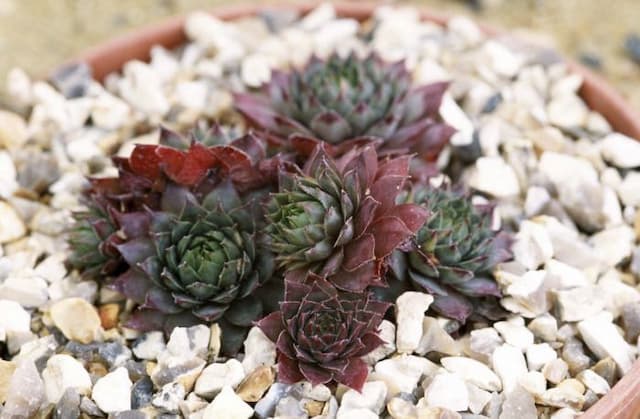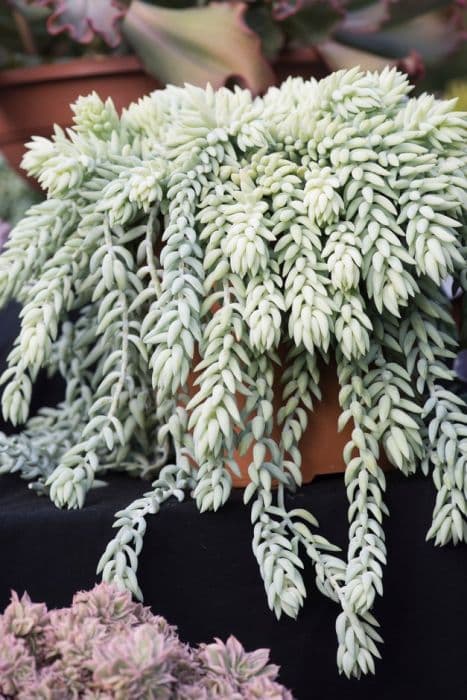Tacitus Bellus Graptopetalum bellum

ABOUT
Commonly known as "Tacitus Bellus," Graptopetalum bellum is a captivating succulent with unique and attractive features. The plant showcases rosettes that resemble flowers in their form. These rosettes are comprised of fleshy, spoon-shaped leaves. The leaves typically exhibit a pale green to bluish-gray color, with hints of pink or purple that can arise when the plant is exposed to sun or cold temperatures. As the seasons change, the Tacitus Bellus produces star-shaped flowers, which lead to a showy display. These flowers are usually a vivid magenta or pink, with each petal marked by white lines converging towards the center, giving the blooms a striking and contrasted appearance. The blooms emerge on slender, arching stalks, further adding to the plant's ornamental appeal. The Tacitus Bellus possesses a compact and clustered growth habit, which makes it an excellent choice for rock gardens, containers, and as a ground cover in suitable climates. Its ability to store water within its leaves allows it to withstand periods without much watering, embodying the hardiness typical of many succulents. The overall appearance of Graptopetalum bellum is one of symmetrical beauty and resilience, making it a favored plant for enthusiasts and gardeners seeking a touch of elegance combined with ease of care.
About this plant
 Names
NamesFamily
Crassulaceae
Synonyms
Chihuahua Flower, Tacitus Bellus
Common names
Tacitus bellus.
 Toxicity
ToxicityTo humans
The common name for Graptopetalum bellum is Tacitus Bellus. It is generally considered non-toxic to humans, and there are no well-documented cases of poisoning from consuming or coming into contact with this plant. However, it is always advisable to be cautious and avoid ingestion of plants not meant for human consumption, as individual allergic reactions or sensitivities can occur.
To pets
Tacitus Bellus, the common name for Graptopetalum bellum, is not known to be toxic to pets such as dogs and cats. There should be no major concerns if a pet chews on or ingests parts of this succulent. Nonetheless, ingestion of non-food plants can sometimes lead to gastrointestinal upset in pets, so monitoring for any unusual behavior or symptoms is recommended if ingestion occurs.
 Characteristics
CharacteristicsLife cycle
Perennials
Foliage type
Evergreen
Color of leaves
Bluish-green
Flower color
Pink
Height
0 feet 6 inches (15 cm)
Spread
1 foot (30 cm)
Plant type
Succulent
Hardiness zones
9
Native area
Mexico
Benefits
 General Benefits
General Benefits- Easy to Care For: Graptopetalum bellum, also known as 'Tacitus bellus', is a low maintenance plant requiring minimal watering and care.
- Drought-Tolerant: This succulent is very drought-tolerant, making it suitable for xeriscaping and water-wise gardens.
- Attractive Appearance: With its star-shaped flowers and rosette form, it adds aesthetic appeal to gardens, windowsills, and arrangements.
- Cold Resistant: Tacitus bellus is more cold-resistant than some other succulents, tolerating temperatures down to about -1°C (30°F).
- Propagation: It is easy to propagate from leaves or offsets, allowing gardeners to expand their collection or share with friends.
- Ground Cover: Its growth habit makes it an excellent choice for ground cover, filling in spaces with attractive foliage.
- Insect-resistant: Generally resistant to pests, reducing the need for chemical treatments in the garden.
- Complementary Plant: Works well in succulent arrangements or rock gardens, pairing nicely with other drought-tolerant species.
- Flowering: The plant blooms in spring to early summer, adding seasonal interest and color to plantings.
- Non-toxic: Tacitus bellus is non-toxic, making it safe for planting in gardens where pets and children may be present.
 Medical Properties
Medical PropertiesThis plant is not used for medical purposes.
 Air-purifying Qualities
Air-purifying QualitiesThis plant is not specifically known for air purifying qualities.
 Other Uses
Other Uses- As a living mulch: Graptopetalum bellum, commonly known as Mexican Hens and Chicks, can be used as a groundcover to retain soil moisture and suppress weeds due to its dense mat-forming growth habit.
- In terrariums: The attractive rosettes and drought tolerance of Mexican Hens and Chicks make it suitable for creating low-maintenance miniature landscapes inside terrariums.
- For green roofing: These succulents can be used on green roofs for their low water requirements and ability to withstand harsh rooftop conditions.
- As a food garnish: Although not commonly consumed, the plant's colorful and unique shape might provide an ornamental touch when used as a garnish for special dishes.
- In themed gardens: Mexican Hens and Chicks can be utilized in rock gardens or fairy gardens due to its whimsical appearance that complements such fantasy-themed spaces.
- As art supplies: The symmetrical rosette pattern of the leaves can inspire designs or be used directly in eco-friendly art projects.
- For bonsai arrangements: Enthusiasts may incorporate Mexican Hens and Chicks into bonsai gardens to add diversity and contrast with traditional bonsai trees.
- In educational projects: Mexican Hens and Chicks can be used to teach children or students about plant propagation, as it easily produces offsets that can be replanted.
- Photography props: The distinctive aesthetic of Mexican Hens and Chicks makes them a great subject or background for botanical photography.
- For dyeing fabric: The pigments of Graptopetalum bellum's leaves may occasionally be used in natural dyeing processes for fabrics.
Interesting Facts
 Feng Shui
Feng ShuiThe plant Tacitus Bellus is not used in Feng Shui practice.
 Zodiac Sign Compitability
Zodiac Sign CompitabilityThe plant Tacitus Bellus is not used in astrology practice.
 Plant Symbolism
Plant Symbolism- Resilience: Graptopetalum bellum, commonly known as "Tacitus bellus," is admired for its ability to thrive in harsh, rocky environments, signifying adaptability and endurance in the face of adversity.
- Beauty: The striking pink star-shaped flowers of the Tacitus bellus embody an aesthetic appeal and are often associated with beauty and appreciation for the natural world.
- Nurturing: As a succulent, the Graptopetalum bellum is adept at conserving water and sustaining itself, symbolizing nurturing and self-sufficiency.
- Benevolence: The ease of care and propagation of the Tacitus bellus represents generosity and the spreading of goodwill to others.
- Serenity: The Tacitus bellus, with its rosettes and calming presence in gardens, is frequently seen as a symbol of tranquility and peace.
 Water
WaterThe Tacoma Stansbury, commonly known as Graptopetalum bellum, needs to be watered thoroughly when the soil has completely dried out. Generally, this succulent should be watered every 7 to 10 days during the active growing season in spring and summer, reducing to once a month in the fall and winter when it is dormant. Use a watering can to soak the soil, providing about 8-16 ounces depending on the size of the pot, ensuring excess water drains away. Over-watering or allowing the plant to sit in water can lead to root rot.
 Light
LightFor the Graptopetalum bellum, also known as the Tacoma Stansbury, it thrives best in bright, indirect sunlight. The ideal spot would be near a window that gets plenty of light throughout the day but is shielded from the intense afternoon sun, which can scorch its leaves. However, some morning or late afternoon sun is beneficial for maintaining its vibrant colors and compact form.
 Temperature
TemperatureThe Tacoma Stansbury (Graptopetalum bellum) prefers temperatures ranging from 65 to 75 degrees Fahrenheit. It can tolerate temperatures as low as 50 degrees Fahrenheit and as high as 85 degrees Fahrenheit, but extreme temperatures beyond this range can be harmful. Keeping the plant in the ideal temperature range encourages healthy growth and flowering.
 Pruning
PruningFor the Tacoma Stansbury (Graptopetalum bellum), pruning is typically done to remove any dead or damaged leaves and to maintain its attractive rosette shape. The best time to prune is in the spring before the onset of the growing season. Trimming back overgrown stems will also encourage more compact growth. Do this annually or as needed.
 Cleaning
CleaningAs needed
 Soil
SoilThe best soil mix for Graptopetalum bellum, commonly known as Chihuahuan Jewel, should be well-draining with a blend of cactus potting soil, perlite, and coarse sand. It's crucial for the soil to have good aeration and dry out quickly to prevent root rot. The soil pH should be slightly acidic to neutral, ranging from 6.0 to 7.5.
 Repotting
RepottingGraptopetalum bellum, also known as Chihuahuan Jewel, should generally be repotted every 2 to 3 years to refresh the soil and provide room for root growth. This plant favors a snug pot, so repotting is often only necessary when the plant outgrows its current container or the soil becomes compacted.
 Humidity & Misting
Humidity & MistingChihuahuan Jewel thrives in low to moderate humidity conditions typical to indoor environments. This succulent prefers dry air and is tolerant of the average household humidity levels, making it well-suited for most homes without the need for additional humidity adjustments.
 Suitable locations
Suitable locationsIndoor
Place Chihuahuan Jewel in bright, indirect light indoors.
Outdoor
Grow Chihuahuan Jewel in partial sun with well-draining soil outside.
Hardiness zone
9-11 USDA
 Life cycle
Life cycleGraptopetalum bellum, commonly known as Chihuahua Flower, begins its life cycle when seeds are dispersed and settle in well-draining, rocky or sandy soil. Germination follows, requiring adequate sunlight and warmth, leading to the emergence of a small rosette of succulent leaves. As the plant matures, it produces more rosettes and forms a clumping habit, with individual rosettes connected by short stems. The Chihuahua Flower reaches its reproductive stage in spring when it blooms, presenting star-shaped flowers, usually pink to red with a white center, attracting pollinators. After pollination, seed capsules develop, dry out, and eventually open, releasing seeds for the next generation. The plant can also propagate vegetatively through leaf cuttings or offsets, which root easily and grow into new plants.
 Propogation
PropogationPropogation time
Spring-Early Summer
Propogation: Graptopetalum bellum, commonly known as the Tacitus bellus or Mexican Hens and Chicks, is best propagated through leaf cuttings which can be undertaken in spring or early summer to take advantage of the active growth period. This method involves gently twisting a leaf from the mother plant, ensuring a clean break. The leaf must be allowed to callous over for a few days to prevent rot when it is placed on well-draining soil. In time, and with periodic watering—being careful not to overwater—roots will develop from the base of the leaf, along with new plantlets. Once the plantlet is well-rooted and has developed a few pairs of leaves, it can be transplanted into its own container.









